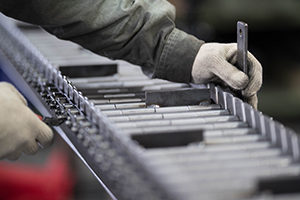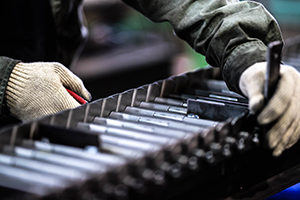Chips vary in nature depending on machining conditions, material, shape, and amount and may cause a variety of different problems. When your conveyor has stopped operating or gone out of order, first contact Tanaka Seisakusho Co., Ltd. (Tel: +81-46-231-5258).
・When installing, adjusting, or repairing a conveyor, be sure to turn off the main power supply before starting the work.
・Never put your arm or foot in or touch the locations with attached warning plates and conveyor openings (chip charging port/discharging port) that may cause physical injury.
・Start the work only after ensuring a safe working environment, including workspace and illuminance.
Information necessary for maintenance
Precautions to observe during maintenance
 If the following information is provided to us, we can efficiently offer maintenance. (Please let us know to the extent possible.)
If the following information is provided to us, we can efficiently offer maintenance. (Please let us know to the extent possible.)
- Machine tool in use (manufacturer name, machine type, such as lathe and machining center)
- Conveyor model concerned (hinge belt, scraper, coil, screw, or other conveyor)
- Information provided on the nameplate (serial number, drawing number, etc.)
Common maintenance issues(Q&A)
Turning on the power supply with no load applied does not start the conveyor.
The cause of the problem described in your question may be any of the following phenomena A to E.
| Phenomenon | Remedy |
|---|---|
| A.Power is not supplied. | →Check the voltage and current of each phase. |
| B.The power line is broken or disconnected. | →Check the circuit. |
| C.Burning of the motor | →Replace the motor. Or check whether the thermal relay is appropriate. |
| D.The breaker is turned off. | →Turn on the breaker. |
| E.The reducer has been damaged | →Replace the reducer or have it repaired by the reducer manufacturer. |
The machine stops in the loaded condition (during startup)
The cause of the problem described in your question may be any of the following phenomena A to F.
| Phenomenon | Remedy |
|---|---|
| A.The chain is extremely slack. | →Adjust the tension by using the take-up. |
| B.Jamming by a block of chips or foreign substance | →Repeat the operation of reverse rotation to normal rotation. Remove the foreign substance after turning off the power supply. |
| C.Damage and deformation of the scraper | →Replace the scraper or correct the deformation. |
| D.Slipping of the torque limiter | →Inappropriate adjustment — Additionally tighten the torque limiter. →Wear of the friction plate — Replace the friction plate. →Remove the abnormal load. |
| E.The motor overheats. | →Check whether the thermal setting value is correct. |
| F.The thermal relay is activated. | →Remove the abnormal load or adjust the setting value. |
The coolant liquid overflows (with backwashing drum filter).
The cause of the problem described in your question may be any of the following phenomena A to E.
| Phenomenon | Remedy |
|---|---|
| A.Clogging of the drum filter | →Because of mixing in of oil — Remove the oil that is attached on the filter. →The volume of injection from the backwashing nozzle is small. — Clean the washing nozzle and Y strainer. →Lack of washing pressure — Set the pressure to 0.05 MPa to 0.1 MPa. |
| B.Coolant liquid is flowed at a flow rate greater than the setting flow rate. | →Adjust the valve to reduce the flow rate to the setting flow rate. |
| C.The type of coolant liquid has been changed (e.g. from water-based coolant to oil-based coolant) | →The flow rate varies depending on the viscosity. |
| D.Coolant liquid in an excessive amount is in the tank. | →Supply water when the pump is stopped, and do not supply water beyond the level gauge upper limit. |
| E.Bubbles cause chips to overflow from the dirty liquid. | →Suppress the formation of bubbles. →Put the anti-foam agent. →Lower the backwashing pressure. |
Decrease of filtering accuracy (with a backwashing drum filter).
The cause of the problem described in your question may be any of the following phenomena A to C.
| Phenomenon | Remedy |
|---|---|
| A.Inappropriate installation of the drum filter | →Check whether the filter is installed with clearances. |
| B.Breakage or wear of the drum filter | →Replace the drum filter. |
| C.Breakage or wear of the oil seal on the rotary part | →Replace the oil seal. |
Other examples of inquiry

- We want to change from a hinge belt conveyor to a screw conveyor (change of conveyor model).
- We want to install a high-pressure pump on the existing tank.
- We want to introduce a centralized conveyor (it can be discussed the introduction if the layout drawing is available).
- Can you supply us with conveyor parts?
- Can you conduct modification or additional work?
- We bought a second-hand machining center, but it is not equipped with a conveyor. So we want to install a conveyor on it.

